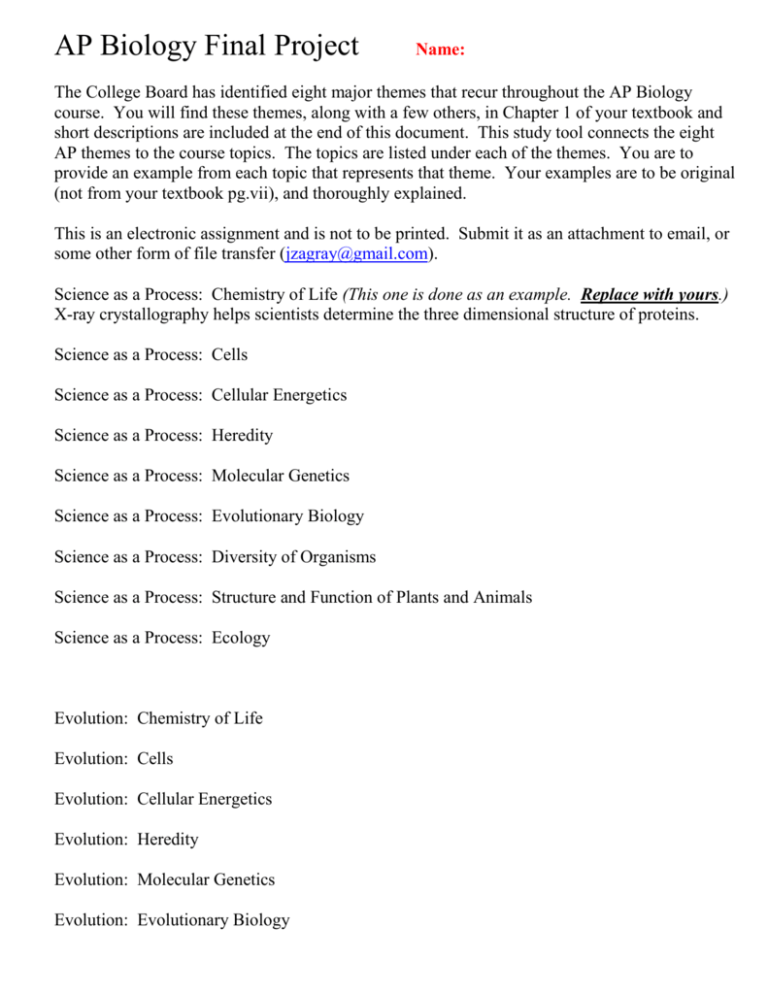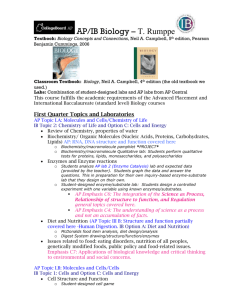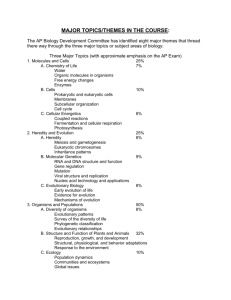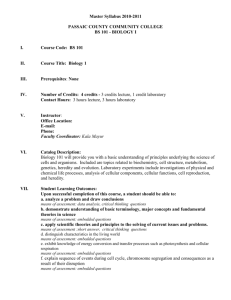AP Biology Final Project Name
advertisement

AP Biology Final Project Name: The College Board has identified eight major themes that recur throughout the AP Biology course. You will find these themes, along with a few others, in Chapter 1 of your textbook and short descriptions are included at the end of this document. This study tool connects the eight AP themes to the course topics. The topics are listed under each of the themes. You are to provide an example from each topic that represents that theme. Your examples are to be original (not from your textbook pg.vii), and thoroughly explained. This is an electronic assignment and is not to be printed. Submit it as an attachment to email, or some other form of file transfer (jzagray@gmail.com). Science as a Process: Chemistry of Life (This one is done as an example. Replace with yours.) X-ray crystallography helps scientists determine the three dimensional structure of proteins. Science as a Process: Cells Science as a Process: Cellular Energetics Science as a Process: Heredity Science as a Process: Molecular Genetics Science as a Process: Evolutionary Biology Science as a Process: Diversity of Organisms Science as a Process: Structure and Function of Plants and Animals Science as a Process: Ecology Evolution: Chemistry of Life Evolution: Cells Evolution: Cellular Energetics Evolution: Heredity Evolution: Molecular Genetics Evolution: Evolutionary Biology Evolution: Diversity of Organisms Evolution: Structure and Function of Plants and Animals Evolution: Ecology Energy Transfer: Chemistry of Life Energy Transfer: Cells Energy Transfer: Cellular Energetics Energy Transfer: Heredity Energy Transfer: Molecular Genetics Energy Transfer: Evolutionary Biology Energy Transfer: Diversity of Organisms Energy Transfer: Structure and Function of Plants and Animals Energy Transfer: Ecology Continuity & Change: Chemistry of Life Continuity & Change: Cells Continuity & Change: Cellular Energetics Continuity & Change: Heredity Continuity & Change: Molecular Genetics Continuity & Change: Evolutionary Biology Continuity & Change: Diversity of Organisms Continuity & Change: Structure and Function of Plants and Animals Continuity & Change: Ecology Relationship of Structure to Function: Chemistry of Life Relationship of Structure to Function: Cells Relationship of Structure to Function: Cellular Energetics Relationship of Structure to Function: Heredity Relationship of Structure to Function: Molecular Genetics Relationship of Structure to Function: Evolutionary Biology Relationship of Structure to Function: Diversity of Organisms Relationship of Structure to Function: Structure and Function of Plants and Animals Relationship of Structure to Function: Ecology Regulation: Chemistry of Life Regulation: Cells Regulation: Cellular Energetics Regulation: Heredity Regulation: Molecular Genetics Regulation: Evolutionary Biology Regulation: Diversity of Organisms Regulation: Structure and Function of Plants and Animals Regulation: Ecology Interdependence in Nature: Chemistry of Life Interdependence in Nature: Cells Interdependence in Nature: Cellular Energetics Interdependence in Nature: Heredity Interdependence in Nature: Molecular Genetics Interdependence in Nature: Evolutionary Biology Interdependence in Nature: Diversity of Organisms Interdependence in Nature: Structure and Function of Plants and Animals Interdependence in Nature: Ecology Science, Technology & Society: Chemistry of Life Science, Technology & Society: Cells Science, Technology & Society: Cellular Energetics Science, Technology & Society: Heredity Science, Technology & Society: Molecular Genetics Science, Technology & Society: Evolutionary Biology Science, Technology & Society: Diversity of Organisms Science, Technology & Society: Structure and Function of Plants and Animals Science, Technology & Society: Ecology Major Themes Science as a Process - Science is a way of knowing. It can involve a discovery process using inductive reasoning, or it can be a process of hypothesis testing. Ex. development of the cell theory or the theory of evolution Evolution - Biological change of organisms that occurs over time, which is driven by the process of natural selection. Evolution accounts for the diversity of life on Earth. Ex. development of antibiotic-resistant disease-causing bacteria Energy Transfer - Energy is the capacity to do work. All living organisms are active (living) because of their abilities to link energy reactions to the biochemical reactions that take place within their cells. Ex. the energy of sunlight, along with carbon dioxide and water, allows plant cells to make organic materials, synthesize chemical energy molecules, and ultimately release oxygen to the environment Continuity and Change - All species tend to maintain themselves from generation to generation using the same genetic code. However, their are genetic mechanisms that lead to change over time, or evolution. Ex. mitosis consistently replicates cells in an organism; meiosis (and hence sexual reproduction) results in genetic variability Relationship of Structure to Function - The structural levels from molecules to organisms ensure successful functioning in all living organisms and living systems. Ex. aerodynamics of a bird’s wing permits flight Regulation - Everything from cells to organisms to ecosystems is in a state of dynamic balance that must be controlled by positive or negative feedback mechanisms. Ex. control of body temperature by the brain Interdependence in Nature - Living organisms rarely exist aline in nature. Ex. microscopic organisms can live in a symbiotic relationship in the intestinal tract of another organism; the host provides shelter and nutrients, and the microorganisms digest the food Science, Technology, and Society - Scientific research often leads to technological advances that can have positive and/or negative impacts upon society as a whole. Ex. biotechnology and the development of the Hepatitis B vaccine and genetically modified plants; environmental consequences of toxic wastes or global warming







